This website is supported by its readers. If you click one of my links I may earn a commission. I am also a participant in the Amazon affiliates program and I will also earn a commission from qualified purchases.

Ficus trees are one of the most popular indoor tree species available. With over 850 species globally, many of you (myself included) keep these to create some added greenery in our homes. Recently, however, one of my Ficus trees started deteriorating in health. This got me asking how to save a dying Ficus tree.
To save a dying Ficus tree, identify the root cause of the Ficus tree’s ill health and counter it. Poor health in Ficus trees is most commonly due to overwatering, poor potting soil, insufficient nutrients, or lack of sunlight.
So what exact reasons can cause a Ficus tree to fall ill and die? And what are the signs that your Ficus tree is dying? Keep reading to find out more!
Just a quick heads up, over the past three years of running Plantpaladin, hundreds of people have asked for product recommendations. As such, You can find my favorite indoor bonsai tree here (link takes you to Bonsaiboy), my favorite outdoor bonsai tree (link takes you to Bonsaiboy), or have a look at all the products I recommend here.
How to save a dying Ficus tree?
Ficus trees are incredible!
They have natural defenses against insect infestation, are one of the few tree species that work better indoors than outdoors, and are generally very easy to care for.
It’s one of the reasons why these trees are used commonly in bonsai and the species that many people use as their first bonsai tree.
These trees, however, are not immortal.
Recently, one of my own Ginseng Ficus trees was starting to drop leaves, attracting more insects, and generally not doing too well.
Naturally, I started to panic, so I got in touch with a few tree experts, visited my local botanical gardens, and even asked 20 Plant Paladin readers for their advice on how to save a dying Ficus tree.
All this ensures that you had the most in-depth post on the web on the topic that should heal your Ficus in no time.
To summarize my findings:
- The most common reason for Ficus trees dying is a lack of sunlight.
- These trees require 4 to 6 hours of sunlight daily.
- Without sunlight, Ficus trees will not be able to photosynthesize correctly and so will not be able to feed themselves.
- To prevent this, move your Ficus tree outdoors if temperatures permit so your tree gets enough light.
- Alternatively, invest in a grow light with the entire light spectrum.
- Other significant reasons Ficus trees die are overwatering, underwatering, poor potting soil, insect infestation, fungal or bacterial infections, nutrient deficiencies, root rot, and dead branches.
- Too much sunlight, moving your Ficus tree too frequently, and a lack of humidity in the air can also be a problem.
- To save a dying Ficus tree, identify the main issue causing your tree to die and then counteract it by following the methods below.
To help summarize the different methods, I’ve put together a table that should help:
How to save a dying Ficus tree – Quick facts
Reason for dying Ficus | How to prevent |
Lack of sunlight | Invest in a grow light or move into bright spot |
Overwatering | Dry the tree, repot the plant and stick to a regular watering schedule |
Underwatering | Stick to a regular wearing schedule |
Insect infestation | Use a natural or chemical pesticide |
Bacterial/mold infection | Use an anti-fungal fungicide to stop |
Wrong potting soil | Repot the tree with water-rich soil |
Poor in nutrients | Fertilize the tree |
Root rot | Repot the tree and trim the roots |
Too much sunlight | Move indoors or into the shade |
Dead branches or leaves | Remove and trim back your tree regularly |
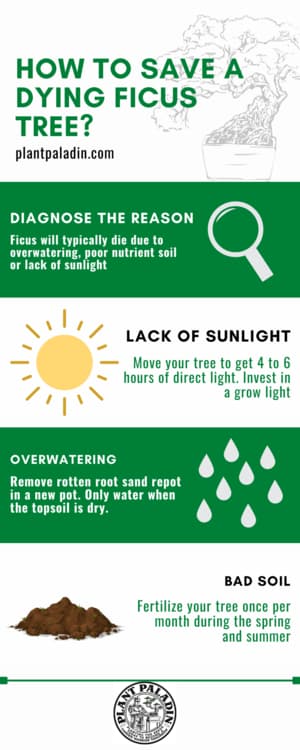
Let’s explore how to save a dying Ficus tree in more detail below.
Ensure your Ficus gets enough sunlight
So the first step to saving a dying Ficus tree is to ensure your Ficus gets enough sunlight.
While many of us can grow these trees successfully indoors, the truth is, like all plants, Ficus trees require at least 4 to 6 hours of sunlight per day to survive.
Ficus trees will use this sunlight and, in turn, convert it into food via photosynthesis.
In their natural environment, Ficus trees are often kept in warmer, more tropical climates, where temperatures seldom drop below 15 degrees Celsius at night.
Many of us live in counties like the UK that don’t see that much sunlight year-round.
How to tell your Ficus is not getting enough light?
The most significant symptoms to look out for when it comes to a lack of sunlight on your Ficus is that the tree leaves are slowly changing color, starting to wilt and transforming from their natural green to yellow and whites.
Other surefire signs you need to give your tree more sunlight would be the stems and branches of your tree becoming more protracted and thinner as they try to find better courses of light.
How to save?
To ensure your Ficus tree gets enough sunlight, move it into a brighter spot.
If you want to keep your Ficus indoors, move it to a south or west-facing window where it can get plenty of filterest sunlight through the day.
Alternatively, if you live in a space without many windows, consider investing in an LED grow light with a full-color spectrum to ensure your fig tree meets its UV needs.
Finally, consider moving your Ficus outdoors to benefit from natural light if you live in warmer conditions.
Prevent your Ficus from getting too much sunlight
While this is much rarer, your Ficus may be dying because your tree is just getting too much sunlight.
Most Ficus trees will be happy with 4 to 6 hours of sunlight per day.
That will usually be achieved through filtered sunlight, meaning sunlight drawn directly through netting or windows.
How to tell your Ficus is getting too much light?
The most common way to tell that your Ficus is getting too much sunlight is by the leaves of your Ficus becoming brittle, drying up, and falling off.
Your topsoil may also start to crack, a surefire sign of drought in your Ficus.
How to save?
In this instance, the best way to prevent this is to avoid keeping your tree out during the brightest part of the day.
Invest in things like window netting or blinds that only allow a partial amount of light through instead of blasting your tree with a lot of light.
If you have recently purchased your Ficus, you may have to go back and forth between giving your Fig tree either too much light or too little light until you calibrate what works best for your tree.
Stop Overwatering
Another widespread reason why Ficus trees can die is just by overwatering them.
Ficus tres and Ficus bonsai require a lot of water, so you must check them daily to check their moisture levels.
That being said, we often like to overcompensate when watering our Ficus, meaning that it can be effortless for water-borne diseases such as root rot or mold infections to start appearing.
How to tell if you have overwatered your Ficus tree?
The main symptoms of an overwatered tree are yellowing leaves or wilted leaves.
If the potting soil is still wet or moist a few days after you last watered your tree, then there is a good chance you may have overwatered your tree.
If the overwatering is severe, then expect mold infections such as root rot also to start appearing.
How to save?
We will cover root rot during the next point, but to stop yourself from over watering your tree, check your potting soil daily before you water your tree.
If the topsoil is dry to touch, then your tree needs watering.
If the topsoil is still moist, wait 24 hours before rechecking its moisture levels.
Prevent bottom watering your tree and use a watering can spray water over the top of your Ficus.
Consider using rainwater too, which can contain less fluoride than tap water.
Another alternative method to help dry out your tree would also include planting your tree in the ground outdoors (pending the temperatures being warm, so only doing this during the summer) or simply repotting your tree.
Remove root rot
As mentioned above, root rot is a severe consequence of overwatering your Ficus tree.
Root rot happens when too much water builds up in the soil.
Fungi like Pythium, Phytophthora, Rhizoctonia, and Fusarium build up in the soil. Eventually, mold will start to appear on the roots.
If left unchecked, this will prevent the roots from absorbing nutrients, water, and most importantly, oxygen from your tree’s soil and generally cause the decline in your tree.
Think of it of how rising dampness will impact a house.
It might start small, but over time it can weaken the structural integrity of a home.
How to tell if you have root rot?
The main symptoms of root rot will be the same as overwatering your Ficus tree, but there are also a few separate things you should remember.
These include leaves of your Ficus that have started to shrink without pruning, stunted tree growth, Branch dieback, cankers, and other lesions suddenly growing on your Fig tree.
White spots and white powder noticeable on your leaves are also signs of Mold infection/root rot.
How to save?
The primary way to prevent root rot is to remove the hazardous roots to prevent the infection from spreading to good roots and then repotting your tree.
Now I’ve written an entire post about repotting Ficus trees but to summarise:
Use a root hook to prey the topsoil of your Ficus tree lose.
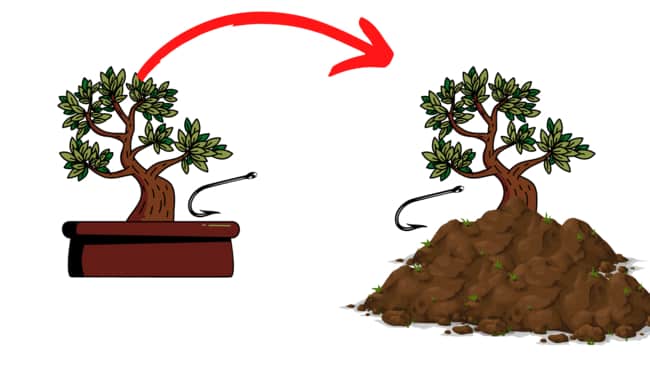
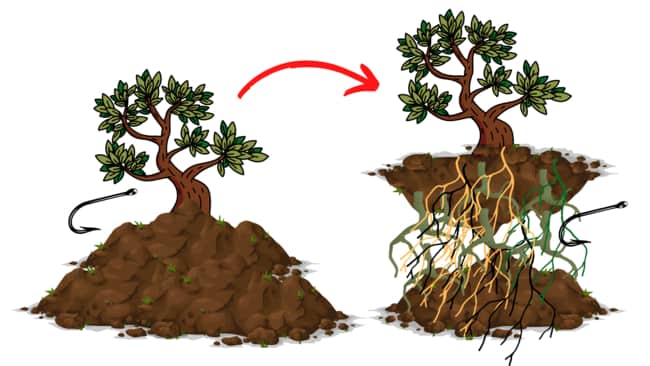
Remove any excess soil and then remove any roots that have root rot on them – these will typically look like roots look wet or darkened and should be easily discernible compared to everyday healthy roots.

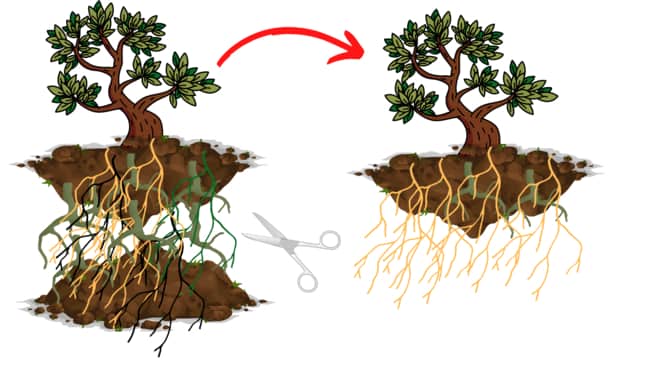
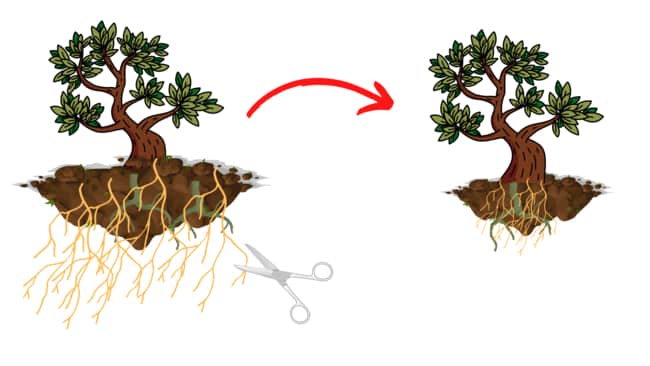
Once removed, clean your old pot with liquid soap or, better yet, invest in a new pot.
Using copper or aluminum wire, tie a wire in to hold the Ficus in place.

Then fill with potting soil and tie around the Ficus branch to hold the tree in position.
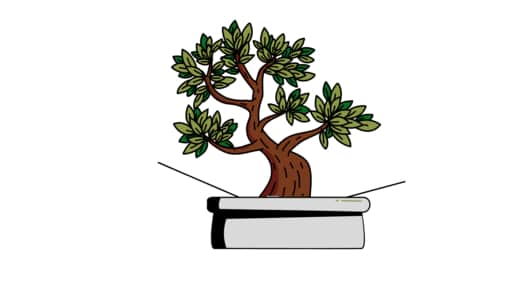
Maintain correct aftercare, and you will have successfully repotted your tree.
As a rule of thumb, considers repotting your Ficus every 2 to 3 years.
Repotting will also help prevent your tree from outgrowing the pot it lives in and the roots of your tree from becoming crushed.
Invest in better potting soil
So root rot and the general symptoms of overwatering your Ficus tree can usually be resolved early by simply replacing the potting soil of your Ficus.
Ficus soil needs to provide enough aeration, so your roots don’t become suffocated; hold onto enough water so your tree does not try out and allow moisture to flow, so you do not overwater your tree.
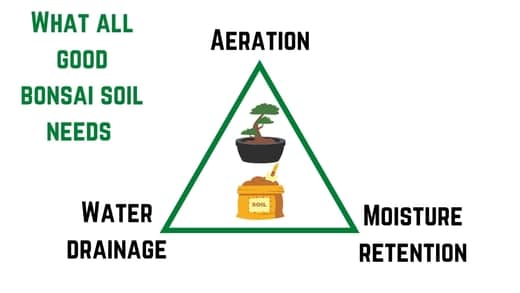
Luckily most inorganic mixes work very well for Ficus trees and other deciduous and semi-deciduous tree species.
How to tell if you need to change potting soil?
Again, similar to the point above, if your tree has yellowing leaves, random legions, stunted growth, and root rot, then the consensus is that you will need new potting soil.
When repotting your Ficus tree on the back of root rot, ensure you always use fresh potting soil as the existing one will have been contaminated by a host of fungi.
How to save?
To save, invest in new potting soil for your tree.
Potting soil should be changed at least once per year during the first five years of your Ficus tree’s life.
Repotting can then be slowed down to about once every two years.
New potting soil should always be used when repotting your Ficus tree.
The best potting soil mix for Ficus trees will be an inorganic mix of soil.
For best results, consider using volcanic growth or ash rock in your soil mix.
I find the following mix works best:
50% akadama, 25% volcanic lava rock, and 25% Pumice.
To read up more on potting soil, I recommend reading my post on the topic here.
Remove mold infections
So as mentioned, root rot is a nasty infection that can impact your Ficus tree.
Sadly, however, hundreds of other types of mold infections can impact your tree’s health, so using antifungals will give you the best chance of saving your tree.
These infections include butt rot, heart rot, cankers, mildew disease, and rust.
How to tell if your Ficus has mold disease?
The most significant way to tell that your tree has a mold infection is discoloration of the leaves and branches of your tree, scabs forming on the tree’s bark, and moisture and wetness in and around your tree, even during warm conditions.
Other surefire signs are branches not growing or, even worse, falling off during the spring and summer when these trees produce the most.
How to save?
The best thing you can do to prevent mold infections is to use a fungicide to remove any fungi from the tree.
Most fungicides found in garden centers work a treat, so be sure to follow the instructions on the bottle as closely as you can.
Mold infections are caused by fungi which can also be spread through a few different methods, including
- Wind transporting fungal spores
- Garden tools that have fungi on them
- Human or animal movement
- Rainwater
If then you have used fungicide and the tree is still showing signs of mold infection, consider repotting your tree into a new pot (using the method outlined above)
It might also be worth getting new tools such as trowels, shears, and other tools you might use on your Ficus.
Moving your tree indoors and using filtered water will also help with the latter two points.
Prevent bacterial infections
Sadly, it’s not just mold infections that you have to worry about but bacterial infections.
Bacterial infections will typically attack your tree from the inside as opposed to mold, which will naturally impact the outside of your tree.
While this is more common in species like Chinese Elm trees, it can also impact Ficus trees.
How to tell if your Ficus has a bacterial disease?
The most common types of bacterial diseases that impact Ficus trees cause sap to drip out of a Ficus.
Dripping sap might be noticeable from a wet spot starting to form on the tree with sap gradually starting o drip from the same place.
How to save?
While some amount of asp drippage will be acceptable, the truth is that excess drippage can impact how well your tree can absorb nutrients from the soil weekend your tree overall.
Sadly, there is no natural way to treat these bacterial infections, and it is more a case of managing the symptoms than reversing them.
I found then using something like a mix of 10% bleach or rubbing alcohol with 90% water and then applying this via a cloth to the sappy spot on your fig tree can help counter this.
Prevent underwatering
While overwatering is far more common than underwatering, the truth is that another significant why Ficus trees can die is due to underwatering.
With many of us keeping Ficus trees indoors and not in their natural environments, it can be easy to dry these trees out.
How to tell if your Ficus is underwatered?
The main symptoms of an underwatered tree are leaves that start to curl inwards, and the tips of the leaves become brown or yellow.
In some situations, Ficus trees may also droop from the trunk.
Underwatered and overwatered trees can cause leaf drops and yellowing leaves in both underwatered and overwatered leaves.
How to save?
The best way to save Ficus trees that have been underwatered is to set up a regular watering schedule.
You can water ficus trees a few times per week, so to ensure your tree gets enough watering, ensure you check the topsoil daily for its watering needs.
If the topsoil is dry, then water the tree.
Keep your Ficus at the right temperature
As mentioned earlier, Ficus trees require a lot of sunlight.
However, one of the side effects that come along with this is that your tree requires warmer temperatures to survive.
Ficus trees are naturally grown in tropical/arid conditions, meaning they need warmer temperatures – between 60 Degrees F and 100 degrees F to survive.
Keeping your Ficus tree outdoors, for example, in temperatures below 60F at night will impact your tree’s ability to cope in cooler climates.
How to tell if your Ficus is kept at the wrong temperature?
Stunted growth is the best way to tell if you are keeping your Fius at the wrong temperature.
Ficus kept at the wrong temperatures will typically not grow as fast as in average temperatures.
The most accurate way to tell that your Ficus is at the wrong temperatures is to keep an eye on the weather forecast.
If temperatures are too regularly lower than 60 degrees F, ensure you move to a warmer palace.
How to save?
The best way to save a Ficus tree that has been kept at the wrong temperature is to move them into a space with a consistent temperature.
Usually, moving Ficus trees indoors year-round in the same spot will be the best option.
Alternatively, if you have the budget, consider building a small greenhouse to ensure you contain your temperature year-round.
Stop moving your Ficus too frequently
I touched upon temperature changes, but one side effect of moving your Ficus tree too frequently can come along with this.
For example, let’s say you bought a new Ficus tree from the store.
The temperature at your home will not match the temperature from the store.
These subtle changes can impact your tree’s ability to absorb nutrients, sunlight, and all the other tiny subtle differences that affect the health of your trees.
Try to keep your tree in one location and avoid moving it too often.
On top of that, it would also be worthwhile to maintain the airflow of your tree.
Subtle changes in the humidity and airflow of the tree can also impact the health of your tree then if not kept consistent.
How to tell if your Ficus is being moved too much?
Against, similar to not keeping at the right temperature, the prominent symptom of moving your Ficus tree too often will be stunted growth.
Your Ficus may also drop leaves due to sudden shock, which should eventually grow back once the Ficus has gotten used to the temperature.
How to save?
To save your Ficus from being moved too frequently, aim to keep your Ficus in one spot.
Keeping near a window works best, so it gets plenty of sunlight and a consistent temperature.
I would also recommend maintaining these thermostats to a set temperature so no humidity or airflow changes occur.
Remove any insects from your Ficus
Another prevalent reason why Ficus trees die is just pest infestations.
Aphids, Spider Mites, Caterpillars, Scale, and other creepie crawlies regularly attack indoor trees.
As such, if left unchecked, these can kill your Ficus tree.
How to tell if you have an insect infestation?
The exact symptoms of an insect infestation in Ficus will vary depending on the insect; look out for leaves that have been bitten.
You should also note dripping sap or a sticky residue on your tree.
How to save?
Use a pesticide!
Pesticides can be chemical or natural such as using ladybugs or parasitic wasps.
Alternatively, If you don’t want to break the bank, consider mixing a solution of 1 tablespoon of liquid soap with 300mml of water and spraying your tree to kill pests.
Check for nutrient deficiencies
So a more severe reason your Ficus tree could die is nutrient deficiencies.
Ficus trees get most of the nutrients from the soil, so if you have poor or nutrient-poor soil, this can impact your tree’s ability to Photosynthesisise or thrive.
Most Ficus trees require Potassium, Nitrogen, and Phosphorous to prosper.
Other vital nutrients Ficus trees need include – Calcium, Magnesium, and Zinc.
How to tell if your soil doesn’t have nutrients?
The main thing to keep an eye out for when it comes to nutrient deficiency in Ficus is the laves of the tree.
Nutrient deficiency symptoms show up there first, and you should pay careful attention if you think this is the case.
To help, I’ve put together a table below with some of the differences depending on the nutrients:
Nutrient | Deficiency Symptom |
Magnesium | Yellow between leaf veins |
Potassium | Brown leaf edges |
Zinc | Bronze patches on young leaves |
Calcium | Paler colored leaves than older leaves |
Phosphorous | Brown/purple/reddish spots on the leaves |
Nitrogen | Yellowing Leaves |
How to save?
The best way to prevent this is by using nutrient-dense soil mixes.
You should change the soil in Ficus tres after a year or so (or when repotting your tree), so consider using organic soil mixes in your potting soil for your Ficus or use nutrient-rich compost.
Fertilizers can also be used to boost the nutrients in your tree further.
Just ensure that these have a balanced N-P-K ratio to ensure even distribution of the different nutrients.
You can use fertilizer monthly during the summer months in Ficus trees.
Some soils are made from recycled coffee grounds – I would avoid these due to the acidic nature of the grounds.
Prune your Ficus regularly
Finally, it would be best if you undertook general care to prevent your Ficus tree from dying.
The larger your tree, the greater chances of a dead tree.
Lack of care can also make things like bacterial infections or pests easier to grab your tree.
As such, keep in mind the silhouette of the tree you want to go for and maintain the tree structure via regularly trimming and pruning.
Signs that your Ficus tree is dying?
The main signs that your Ficus tree is dying include shrunken dried, or yellowing leaves, stunted growth, dry or overly wet soil, insect infection, or mold infestations.
Is your Ficus dying?
So as mentioned, Ficus trees are semi-deciduous.
During the year, the leaves may fall off for up to 6 weeks.
As such, many of us think that the leaves falling off our Ficus trees mean that the tree is dying when in reality, it is all in the tree’s lifecycle.
When moving your Ficus from room to room or from the store to your home, leaves may also fall off due to stress, but these will most commonly grow back after a few weeks and is not a sign of your Ficus tree dying.
What species of Ficus are more prone to dying?
Ficus species with more leaves are more susceptible to dying. The tree will have to maintain the larger leaf canopy when its health deteriorates. Ficus Elastica and Ficus Lyrata are two examples of large leaves in Ficus trees.
Other trees such as Ginseng Ficus or Ficus Nitida will be easier to care for.
If you want the most straightforward job possible, consider investing in an artificial silk Ficus tree. This Faux tree will look the part, but you won’t have to worry about these trees dying on you.
How long do Ficus trees live?
Ficus trees will typically live to 25 years old if kept indoors. The average lifespan for Ficus trees is 20 to 40 years. Ficus trees are grown outdoors in the wild, kept in perfect conditions, or used as bonsai and can live for over 100 years.
It’s not uncommon for some Ficus bonsai to live for over 200 years.
To read more about how old Ficus trees live, check out my post here.
What to do if your Ficus tree is dead?
If your ficus tree is dead already, you might think to throw the whole thing out.
After all, bacteria, insects, and fungi will all astart gravitating towards your tree to decompose it.
While giving it to your local garden waste disposal center is the best thing to do, I would suggest taking a few cuttings from your fics before getting rid of it in its entirety.
Sometimes, the entire tree can be dead bar a few branches, so you can propagate these cuttings to clone your tree.
To do so, check out my post on growing trees with cuttings here.
What causes a Ficus tree to die?
Overwatering, underwatering, mold or bacterial infection, root rot, not getting enough sunlight, or not having nutrient-dense soil are the leading causes of a dead ficus tree.
What do the experts say?
Finally, I didn’t just want to give the information I found about how to save a dying Ficus tree, so I reached out to a few experts to gather their opinion.
First, I reached out to my local botanical gardens and asked them how to save a dying Ficus tree
“The biggest reasons have to be over weathering, lack of sunlight or lack of good soil, definitely one of those three”
I also undertook a quick survey of 10 plant paladin readers and asked them how to save a dying Ficus tree, and you can see the results below:

Many of you are reading this post may have recently purchased Ficus trees.
As such, I wanted to share a brief care guide in the table below, which should help give you some pointers as to the general care of a Ficus tree:
How to save a dying ficus tree – Ficus tree care table?
Ginseng Ficus Bonsai tree Requirements | Explained |
Water | Once per day in the spring-summer or if kept indoors. Once per week if kept outdoors during the winter. Only water if dry to touch. |
Sunlight | 4 hours of direct sunlight in the summer. LED grow light can also be used. |
Temperature | Between 60 degrees F and 100 degrees F |
Fertilizer | Fertilize 18 times per year, twice per month between spring and summer. Once per month in the fall and winter |
Repotting | Once every 2 to 3 years in the first 10 years. You can then report once every 5 years |
Placement | Can be placed outdoors in direct sunlight or indoors in a bright spot. |
Wire type | Both copper and aluminum wire can be used. |
Time to grow from scratch into maturity | 8 to 12 years to reach full maturity |
Potting soil | An inorganic Akdama, volcanic ash soil mix works best. |
Growth type | Slow growing, averaging 3-5 inches per year |
Size | Average store-bought trees are size is one or two-handed bonsai trees - 3 to 10 inches in size, 2 to 8 inches wide |
Lifespan | 50 to 150 years |
Fruit | figs |
Feel free to check out the following posts, too, which can also help care for your tree:
My top picks for the gear you will need!
So like I mentioned earlier, over the past three years of running PlantPaladin, hundreds of people have asked me for my recommendations on the best bonsai gear on the market.
Having spent thousands of dollars on bonsai items these past few years and tested at least 100 bonsai-specific products, I’ve listed my favorite products below – All of which I highly recommend and think you can get great value.
They can purchase directly by clicking the link to take them to Amazon.
Bonsai Tool Set: One of the significant challenges I’ve had is finding a toolset that was not only durable but didn’t break the bank. SOLIGT has recently developed a fantastic bonsai tool set that covers all the tools you need to trim, prune, and repot your trees. – You can grab it here.
Complete Bonsai Set: Many of you will want to grow your bonsai trees entirely from scratch, but finding the varicose seeds, pots, and other items in one place can be challenging. Leaves and Sole then have created a complete bonsai set that I’ve personally used that ticks all the boxes. You can grab it here.
Bonsai wire: The number of times I’ve run out of wire for my bonsai or purchased cheap bonsai wire that doesn’t do the job is embarrassing for me to admit. After a lot of trial and error, I found that using Hotop’s aluminum bonsai wire is one of the best options on the market. This can easily be used for both indoor and outdoor bonsai. You can grab it here.
This post was written by Fehed Nicass who has been passionate about bonsai for over 3 years. He currently resides in the UK and works in sales
